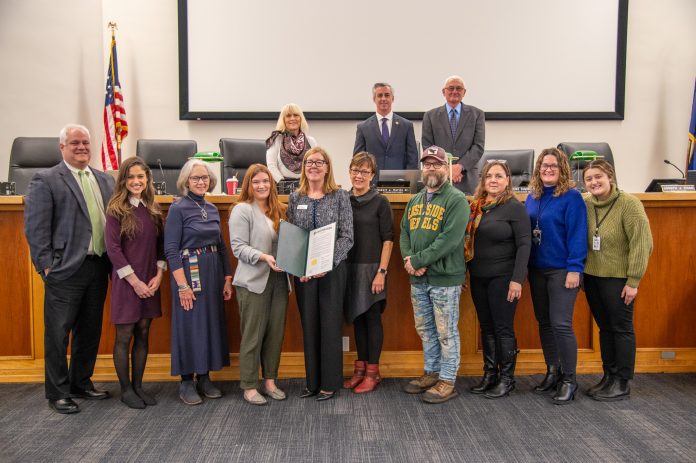In recent months, there’s been an influx of young women on TikTok detailing disturbing incidents at Target, Walmart and other stores across the country. Each shares a similar format — while browsing the aisles or walking to their car, they noticed a man (sometimes with a friend) staring at or following them. The majority tell their followers that they “almost got trafficked.”
While these are certainly concerning situations and should not be taken lightly, Elyse Hoekstra, organizer of the Bucks Coalition Against Trafficking, wants the public to know the facts, especially since January marks Human Trafficking Awareness Month.
According to Hoekstra, there are misconceptions about what human trafficking actually looks like.
“The reality is that this crime is really personal and, in most cases, you’re trafficked by people that you know. You can be trafficked by a loved one, a husband, or a boyfriend or a girlfriend,” she explained. “A lot of times, this misinformation is spread with good intentions, but sometimes it does more harm than good because it’s not really spreading the information about how trafficking actually happens.”
Part of the Bucks Coalition Against Trafficking’s mission is to educate the community on human trafficking, which involves the exploitation of a person for labor or sex acts through the use of force, fraud or coercion.
According to the Polaris Project, human trafficking is the second most profitable criminal industry worldwide, with an estimated 40.3 million victims, 80 percent of whom are women and children.
BCAT, which this month is celebrating its 10th anniversary, operates under NOVA, which supports victims of all crime in the county.
Regarding trafficking statistics in Bucks County, Hoekstra said it’s hard to provide an exact statistic because of the nature of the crime. In 2022, NOVA served 50 victims, though there were likely more.
“It’s really difficult to say how much trafficking is happening in Bucks County just simply because this is a hidden crime. It happens behind closed doors and it takes a lot for a victim to finally feel ready to come forward and report that crime,” she said. “In Lower Bucks County, we’re seeing a lot of trafficking happen out of hotels because that’s where most of the hotels in the county are located.”
Oftentimes, when police conduct raids at these locations, BCAT advocates will accompany law enforcement to assist the victim. In fact, BCAT has a special Victim Focus subcommittee that works to connect survivors with vital resources.
Other subcommittees include Community Outreach (educates the public, responds to potential trafficking situations), Law Enforcement and Prosecution (trains and empowers law enforcement to identify and respond to trafficking situations), and Legislation and Public Policy (influences legislative initiatives related to trafficking).
While this crime can happen anywhere and anytime, Hoekstra provided some warning signs to watch out for.
“Traffickers prey on people with vulnerabilities. So they’re looking for people who are easy to exploit and I always say that they have a gap to fill. Traffickers are looking for that gap and to build dependency and build a connection initially,” she said. “Because they use psychological manipulation and sometimes violence, we always say to keep an eye out for people who are not speaking for themselves. A trafficker is someone who’s behind them, always answering questions and this person is silent next to them.”
Victims usually don’t have control over finances and are often given gift cards to pay for things rather than a credit card. When at the hospital, they typically don’t have a valid explanation for how they sustained an injury. Other indicators of a trafficking victim include lack of a stable living situation, no possessions, including ID, and no sense of where they are. Some traffickers, said Hoekstra, even brand their victims with a tattoo. If one is spotted on a child, it’s a clear red flag.
Many times, sex trafficking victims are misidentified as prostitutes. Ted Krimmel Jr., Lower Southampton Township Chief of Police, said his department takes steps to avoid this confusion.
He said, “Our officers are trained to look for signs of human trafficking during prostitution investigations and contacts with people who appear to be recent immigrants.”
Hoekstra stressed that there are ways to avoid becoming a trafficking victim. In addition to staying educated on what exactly trafficking looks like, individuals should set safe and healthy boundaries … especially with anyone they meet digitally.
“Online trafficking is way up since the pandemic. About 50 percent of cases are now starting online, so really make sure that you know who you’re speaking to, your privacy settings are safe, you’re not oversharing personal information or vulnerabilities online,” she said. “Traffickers are tricky. They’re gonna go where they can build connections.”
With Human Trafficking Awareness Month underway, Hoekstra shared how residents can participate. They can conduct research via accurate sources, such as the Polaris Project and Human Trafficking Hotline, and have informed conversations with friends and family.
On Jan. 25, at 5:30 p.m., residents can attend the next BCAT meeting. Through Zoom, they’ll hear from Jackie Goldstein, MSW, LSW, forensic interview specialist for Homeland Security Investigations (Philadelphia Office). She’ll discuss what tactics traffickers use to recruit victims and what kind of trafficking is seen in Bucks County and Pennsylvania.
Additionally, the Bucks Coalition Against Trafficking is always looking for new members. More information is available at novabucks.org/get-help/bucks-coalition-against-trafficking/.
Samantha Bambino can be reached at [email protected]


